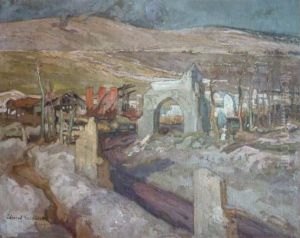Edmond Lesselier Paintings
Edmond Lesselier was a French painter born in 1863, whose work is often associated with the impressionist and post-impressionist movements. Despite not being as widely recognized as some of his contemporaries, Lesselier's contributions to the art world during the late 19th and early 20th centuries were significant, particularly in the realm of landscape painting. He was known for his ability to capture the ephemeral qualities of light and atmosphere in his depictions of the French countryside and coastal scenes.
Lesselier's artistic journey began at a young age, showing an early aptitude for drawing and painting. He pursued formal art education in Paris, where he was exposed to the burgeoning impressionist movement that was beginning to take hold among French artists. This exposure had a profound impact on his stylistic development, steering him away from the more rigid and formal techniques of academic painting towards a looser, more expressive approach characterized by the use of vibrant color and dynamic brushstrokes.
Throughout his career, Lesselier exhibited his work in various salons and galleries, gaining modest acclaim. His paintings often portrayed the natural beauty of France, from the rugged coastlines of Normandy to the serene landscapes of Provence. Lesselier's ability to imbue his landscapes with a sense of mood and atmosphere was particularly admired, with critics noting his skill in rendering the changing lights of day. Despite this, he never achieved the same level of fame as some of his peers, such as Claude Monet or Camille Pissarro, which has led to him being somewhat overlooked in the annals of art history.
Edmond Lesselier continued to paint and exhibit his work until his death in 1931. Today, his paintings are held in several regional museums in France, and occasionally appear in international auctions, where they are appreciated for their contribution to the development of impressionist and post-impressionist painting. Lesselier's body of work serves as a testament to the rich tapestry of artists who contributed to these movements, reminding us of the diversity and depth of talent that existed during this transformative period in art history.
